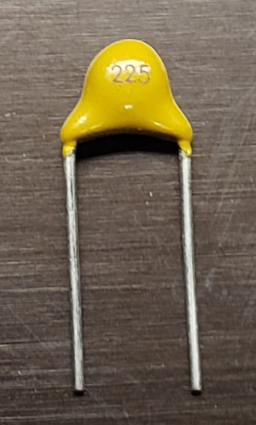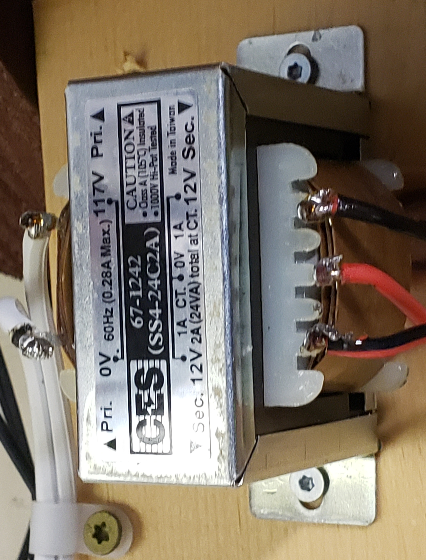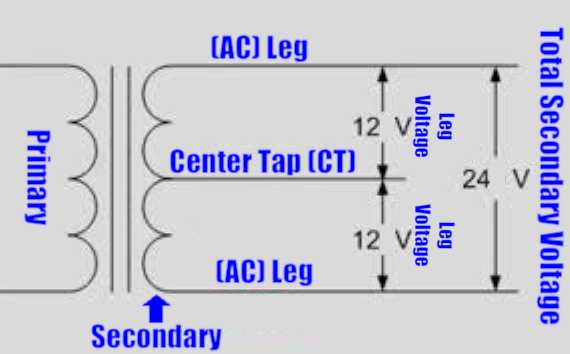§ 12 - Glossary
AC |
| Alternating Current — In the context of audio circuitry, an AC-coupled circuit has bass response that rolls off (responds less) as the frequency of the audio goes lower. A DC-coupled circuit, on the other hand, will respond to low frequencies without attenuation at all.
AC is also often used as a shorthand to refer to the alternating current power available from a household wall socket. |
amp |
| The term amp is short for ampere, a current rating. |
ARO |
| Amateur Radio Operator, or HAM radio operator |
C |
| Capacitor
For instance, C1 means "Capacitor one." |
D |
| Diode
For instance, D4 means "Diode four." |
dB |
| A dB, which stands for Decibel, is a relative unit of measurement; this means that it represents a deviation from a known reference value. It can be used to express a value change or an absolute value. For power levels, a change in power by a factor of 10 corresponds to a 10 dB change in level. For voltage, change in amplitude by a factor of 10 corresponds to a 20 dB change in level.
For both power and voltage measurements, 0 dB indicates no change, or a 1:1 ratio between two values. More information on the dB can be found here. |
DC |
| Direct Current — In the context of audio circuitry, a DC-coupled circuit will respond to low frequencies without attenuation. Whereas an AC-coupled circuit has bass response that rolls off (responds less) as the frequency of the audio goes lower. |
DVM |
| Digital Volt Meter. Used to (hopefully) precisely measure voltage in a live electronic circuit. |
E |
| This is the letter used to indicate voltage in electronic formulas. |
electrolytic |
| A polarized electrolytic capacitor is a capacitor with a relatively large uF rating that is often used to store energy. The designation "polarized" means that it only works when voltage is applied to it in such a way that the + terminal is more positive than the - terminal. Here is a typical example:
|
HAM |
| Amateur radio operator, or ARO. Why call them HAMs? Wikipedia Knows! |
Hz |
| Hertz — Cycles per Second. |
I |
| This is the letter used to indicate current in electronic formulas. |
IC |
| Integrated Circuit. Another common abbreviation is U.
For instance, IC2 means "Integrated Circuit two." |
J |
| Jumper
For instance, J1 means "Jumper one." |
k-ohm |
| The k in k-ohm means thousand, so 10 k-ohms is 10000 ohms. |
LED |
| Light Emitting Diode
For instance, LED2 means "Light-Emitting Diode two." |
leg |
| In the context of a transformer for the Power Block, a leg is a connection to the secondary winding of a transformer that is not the center tap.
The secondary's center tap is connected to the Power Block's CT terminal, while the secondary's two legs are connected to the two AC terminals. Either secondary leg can be connected to either of the Power Block's two AC inputs; the Power Block will work fine either way. The CT terminal, however, must be connected to the transformer's center tap. |
line-level |
| Line level is approximately 1.23 volts AC; standard line-level input impedance in 10 k-ohms. |
ma |
| milli amperes (thousandths of an ampere) of electrical current
For example, 5 ma is .005 amperes. |
ohms |
| Electronic resistance is measured in ohms. |
PC |
| Printed Circuit (board) |
PCB |
| Printed Circuit Board |
peak |
| Equal to 1.414 times the RMS value. You can derive the RMS value from the peak value by multiplying the peak value by .707 |
PIV |
| Peak Inverse Voltage — The maximum reverse voltage a semiconductor such as a diode or transistor can withstand before suffering catastrophic failure. |
polarity |
| Some electronic parts are polarized, which means they can only be connected one way; there's a wrong way to place them in a circuit board, and you really don't want to do that.
Black Belt Systems products have polarity indications or cues on the circuit board for all polarized components. For round LEDs, typically there are two cues. The longer lead is the anode; and the lead that comes out of the side of a round LED that has a flattened edge is the cathode. For rectangular LEDs, the lead length may be your only cue. If in doubt, test the LED using a current limiting resistor before soldering it into place. For rectifier diodes, observe the bar on the end of the component drawing on the circuit board guide, and make sure you match the orientation of the bar on the diode to the orientation of the bar on the guide. For polarized capacitors, one leg of the capacitor is + and the other is - so see to it that they are inserted as indicated on the guides. Warning: For dual negative and dual positive Power Block builds, refer to the appropriate build guide linked on this page, rather than the silkscreening on the circuit board; three of the diodes, one of the regulator ic's, one of the LEDs, and one of the polarized capacitors will be inserted according to the guide, not according the silkscreened layout on the PCB.
|
R |
| Resistor; also used to represent resistance in electronic formulas.
For instance, R9 means "Resistor nine." |
RFI |
| Radio Frequency Interference. |
RMS |
| Root Mean Square — equal to .707 times the peak value. You can derive the peak value from the RMS value by multiplying the RMS value by 1.414 |
SWL |
| Short Wave Listener |
T |
| Transformer
For instance, T1 means "Transformer one." |
transformer |
| In the context of the Power Block, a transformer is an inductive device that has two windings, a primary and a secondary. These windings are wrapped around a core of metal that constrains magnetic fields; that core assists in transferring energy from the primary winding to the secondary winding.
The primary is connected to line voltage, which is typically 117 vac in the USA. This connection is typically made through a fuse and a switch, both for safety and practicality. To be compatible with the Power Block, the transformer's secondary must be center-tapped. That center tap is wired to the Power Block's CT connection, while the secondary's two legs are wired to the two AC connections. Either secondary leg can be connected to either of the Power Block's two AC inputs; the Power Block will work fine either way. The CT terminal, however, must be connected to the transformer's center tap. |
U |
| A common abbreviation for an integrated circuit. Another common abbreviation is IC.
For example, U1 means "Integrated Circuit One." |
uF |
| micro Farad — A measure of capacitance. One millionth of a Farad.
For instance, 1 uF equals .000001 Farad. |
USD |
| United States Dollars |
VAC |
| Volts Alternating Current. |
VDC |
| Volts Direct Current. |
watt |
| This is the unit for power, and power-dissipation. Electronic components must always be able to get rid of the heat resulting from the power dissipated in them. |
WV |
| Working Voltage — The maximum voltage a capacitor may be exposed to before catastrophic failure. |
Website Keyboard Navigation
, Previous Page . Next Page
o Ordering g Glossary s Sitemap u Updates
, Previous Page . Next Page
o Ordering g Glossary s Sitemap u Updates




